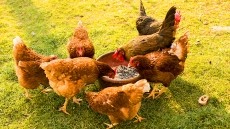US organic feed imports may see boost from increased demand, reduced production

Organic industry commodity monitoring and trading company, Mercaris, released a report forecasting US organic production, market demand and import expectations. The report is based on industry surveys and interviews with producers.
Ryan Koory, director of economics, Mercaris, said: “We try to act as a primary data provider for the organic and non-GMO commodity markets."
“We get a combination of the nuts and bolts – the quantitative element of what’s going on in the market – as well as qualitative, on the ground perspective,” he told FeedNavigator.
This year, the US organic feed grain production sector has faced many of the same challenges as conventional production. “We had this protracted long, cold, wet spring that made planting a significant issue this year,” said Koory.
However, organic producers faced an extra challenge, trying to manage cover crops in rain-soaked fields, he said.
“Ultimately, what we see is a reduction in area planted because it was such a challenging planting season this year,” Koory said. “These reductions are primarily occurring across the prime growing areas for feed grains in the US, across the US Corn Belt and across the northeastern part of the US."
“It’s harder to get a crop to maturity under those conditions,” he said. “We’re looking at lower yields and lower area planted, and lower area harvested – and if you reduce your yield and area harvested that paints a sharply lower picture for overall production.”
Corn, soy production and import forecast
In total, the forecast is for US organic corn production of around 36.4m bushels – a drop of 12% from the previous year, Mercaris reported. Even with an expected increase in imports, total organic corn supplies are predicted to be down 1% from the previous marketing year.
Imports of organic corn and cracked corn are expected to increase by about 28%.
Feed demand for corn is predicted to grow by 1%, read the Mercaris outlook.
Along with organic feed corn production, corn silage growth in the US is forecast to be down by about 8%, found the report.
“The reduction in corn silage – it’s kind of a similar story, we just didn’t get the same number of acres put in," said Koory.
Corn silage plays an important role in rations for organic dairy cows: “If you’re not going to have that silage component in the feed ration, that’s got to get offset with something else – and typically that’s with feed corn. If we have a tighter feed corn situation already, that puts [on] extra strain,” he added.
Similarly, US organic soybean production is expected to fall to about 7m bushels – a decline of 14% year-on-year, according to company information. Total organic soybean supplies are forecast to drop by 5%.
Organic soybean imports are anticipated to increase by 2% from last year, and organic soybean meal imports are expected to grow by 8%, Mercaris reported.
Total organic wheat production – both spring and winter wheat – is forecast to increase by 7% from the previous year; however, the expansion is in food-grade wheat. Winter wheat is anticipated to fall by 19%.
Feed price, demand
Organic feed prices have been somewhat steady, said Koory. With production challenges earlier in the year, there was an effort to forward contract feed grains, which may have reduced volatility in the market, he said.
The organic sector also has some carryover stocks this year, which is atypical for the sector, he said.
“The industry seems to be in a position where nobody really needs to make a buying move, and nobody wants to make a buying move until they understand what the crop looks like – and that has put us in a sideways situation, but it can’t last,” he said. “If you cut production and increase demand that has to be translated into higher prices.”
The demand for organic livestock feed in the US is expected to grow in 2019/20, but only by about 1%, said Mercaris.
Organic dairy production has been “stagnant” for almost two years, said Koory. “Poultry has seen demand growth, which offsets the slowdown in dairy.”
However, demand for organic eggs and boilers has slowed, he said. “It will continue to expand, if not as robustly as you saw in the past,” he added.
















